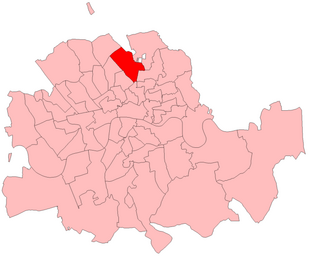
South Northamptonshire is a constituency represented in the House of Commons of the UK Parliament since 2024 by Sarah Bool. As with all constituencies, the constituency elects one Member of Parliament (MP) by the first past the post system of election at least every five years.
Biggleswade was a county constituency in Bedfordshire which was represented in the House of Commons of the Parliament of the United Kingdom from 1885 until its abolition in 1918. It elected one Member of Parliament (MP) by the first-past-the-post voting system.

Ilkeston is a former United Kingdom Parliamentary constituency. It was a constituency of the House of Commons of the Parliament of the United Kingdom. It was represented by one Member of Parliament. In 1983 it was abolished, together with South East Derbyshire, when the Derbyshire county constituencies were redrawn - the constituencies of Amber Valley and Erewash were created and the constituency of South Derbyshire was re-created.
Birmingham Central is a former parliamentary constituency in the city of Birmingham, England. It returned one Member of Parliament (MP) to the House of Commons of the Parliament of the United Kingdom, elected by the first-past-the-post voting system.
Birmingham East was a parliamentary constituency in the city of Birmingham, England. It returned one Member of Parliament (MP) to the House of Commons of the Parliament of the United Kingdom, elected by the first-past-the-post voting system.
Birmingham North was a parliamentary constituency in the city of Birmingham, England. It returned one Member of Parliament (MP) to the House of Commons of the Parliament of the United Kingdom, elected by the first-past-the-post voting system.

Islington East was a constituency which returned one Member of Parliament (MP) to the House of Commons of the Parliament of the United Kingdom from 1885, until it was abolished for the February 1974 general election.

Clapham was a borough constituency in South London which returned one Member of Parliament (MP) to the House of Commons of the UK Parliament. It was created in time for the 1885 general election then altered in periodic national boundary reviews, principally in 1918, and abolished before the February 1974 general election. In its early years the seat was officially named Battersea and Clapham Parliamentary Borough: No. 2—The Clapham Division.
Birmingham South was a parliamentary constituency in Birmingham which returned one Member of Parliament (MP) to the House of Commons of the Parliament of the United Kingdom from 1885 until it was abolished for the 1918 general election.
Liverpool Everton was a borough constituency represented in the House of Commons of the Parliament of the United Kingdom. It elected one Member of Parliament (MP) by the first past the post system of election.
Blackpool was a parliamentary constituency centred on the town of Blackpool in Lancashire. It returned one Member of Parliament (MP) to the House of Commons of the Parliament of the United Kingdom.

Strand was a parliamentary constituency in the Strand district of the City of Westminster. It returned one Member of Parliament (MP) to the House of Commons of the Parliament of the United Kingdom.
Thornbury was a county constituency centred on the town of Thornbury in Gloucestershire. It returned one Member of Parliament (MP) to the House of Commons of the Parliament of the United Kingdom, elected by the first past the post voting system.
Birmingham Bordesley was a borough constituency in the city of Birmingham, which returned one Member of Parliament (MP) to the House of Commons of the Parliament of the United Kingdom. Elections were held using the first-past-the-post voting system.
North Northamptonshire was a county constituency in Northamptonshire, represented in the House of Commons of the Parliament of the United Kingdom. This constituency included the majority of the Soke of Peterborough, with the exception of the actual city of Peterborough itself, which was a borough constituency that returned its own MP.
Otley was a parliamentary constituency between 1885 and 1918 centred on the town of Otley, then in the West Riding of Yorkshire and now in West Yorkshire. It returned one Member of Parliament (MP) to the House of Commons of the Parliament of the United Kingdom, elected by the first past the post system.

Newington West was a parliamentary constituency in the Newington area of South London. It returned one Member of Parliament (MP) to the House of Commons of the Parliament of the United Kingdom, elected by the first past the post system.
Western Monmouthshire was a parliamentary constituency in Monmouthshire, Wales. It returned one Member of Parliament (MP) to the House of Commons of the Parliament of the United Kingdom.
Mid Durham was a county constituency represented in the House of Commons of the Parliament of the United Kingdom. It elected one Member of Parliament (MP) by the first past the post system of election from 1885 to 1918.
East Northamptonshire was a county constituency in Northamptonshire, which returned one Member of Parliament (MP) to the House of Commons of the Parliament of the United Kingdom.









